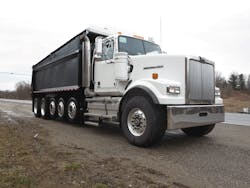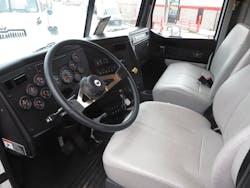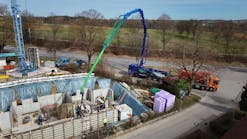Modern vocational trucks seem to be getting more compact. Compared to traditional long-nose conventionals, most of the dump trucks I see in Ohio have shorter hoods that slope rakishly toward the ground ahead. This makes them more practical to drive, plus it cuts weight and cost. But there’s still a market for the big-nosed truck, and most manufacturers offer one. Western Star has the 4900 model, and it’s an example of the type of truck preferred by “old-school” truckers, even if their numbers are dwindling.
That customer description is from Tony Apollonio, sales manager at Fyda Freightliner, Western Star’s branch in Zanesville, Ohio, who made our subject truck available to drive. That it’s a 2019 model and has been on his lot for a while is an illustration of the declining desirability of this type of vehicle among most buyers. Western Star builds 4900s for duties more severe than normal dump trucking, and outfits them with heavier duty frames, axles, suspensions, and powertrains. Although it’s available with Detroit’s 12.8-liter DD13 diesel, as in our test truck, it also can be ordered with the larger DD15 and the X15 from Cummins. They slip right into the compartment sheltered by that long fiberglass hood, whereas the shorter Western Star 4700 model’s biggest engine is the DD13. Optional are the 11.9-liter Cummins X12, as well as the trim 8.9-liter Cummins L9 for those who want to shave off more pounds.
Weight is one penalty paid by buyers of any larger truck, Apollonio said. He compared this 4900 with DD13-powered 4700s in his inventory and concluded that, spec for spec, the 4900 weighs about 1,800 pounds more. Much of that is a longer frame due to the truck’s 17-inch-greater wheelbase, and the rest is the hood itself. At 120 inches, its bumper-to-back-of-cab dimension is 10 to 11 inches longer than a 4700’s BBC. Cabs are the same size, so the BBC’s extra length is ahead of the cowl.
Western Star 4900 Dump Truck Specs
- Truck: 2019 Western Star 4900SF vocational chassis, long-nose conventional, galvanealed steel cab, BBC 120 in., GVW 105,600 lb.
- Engine: Detroit DD13, 12.8 liters (741 cubic inches), 505 hp @ 1,625 rpm, 1,850 lb.-ft. @ 975 rpm, w/ engine brake
- Transmission: Allison 4500RDS torque-converter automatic, 6-speed double-overdrive
- Front axle: 20-000-lb. Meritor MFS-20-133A with TRW-Ross hydraulic power, on parabolic leafs
- Lift axles: 13,200-lb. Hendrickson Composilite forward-steerable
- Rear axles: 46,000-lb. Meritor RT-46-160GP w/ locking differentials and 4.30 ratio, on Hendrickson HaulMaax rubber-block suspension
- Wheelbase: 297 in.
- Brakes: Meritor Q+ drums w/ Wabco ABS
- Tires and wheels: 425/65R22.5 Michelin X on steer axle; 285R22.5 Michelin XFE on lift axles; 11R24.5 Firestone FD835 on tandem drives, all on Alcoa polished aluminum discs
- Fuel tank: 100-gal. aluminum
- Body: 21-ft. ARM Brandon Hardox steel dump
“Dump truckers want lighter weight,” Apollonio said, which explains why the 4700 is more popular among the dealership’s customers. Money-wise, there’s only about $1,500 difference between the two models, again, if outfitted with the same main components.
On this truck, that componentry includes a DD13 mated to an Allison 4500RDS automatic transmission, Meritor axles, and a trio of Hendrickson steerable lift axles ahead of the tandem. This is the common layout to meet Ohio’s bridge formula weight law and still be able to haul 25 or so tons of payload. I’ve seen Ohio dumpers with four pusher-type lift axles, but they are unusual. With six axles and a long enough wheelbase, this six-axle truck can gross 75,500 pounds. A seventh axle and the added wheelbase it needs would add both payload and tare weight, but the truck becomes somewhat unwieldly, especially if it has to do a 180-degree turn-around after delivering a load.
Western Star 4900 Axle Features
A glance at this steer-axle-forward 4900SF might lead one to think that its maneuverability suffers, but I found it easily made 90-degree turns. This is a function of a tight wheel cut on the steer axle, something that engineers can design into a chassis with careful placement of steering gear and other parts. Wide 425-series tires up front have their swing limits, but still, the truck was far easier to steer than other similarly shod axle-forward trucks I’ve driven in the past. With them I had to begin spinning the steering wheel well ahead of the turn, but not so with this 4900. It steered in rather normal fashion, and the TRW-Ross steering system had a nice tight feel with no wandering in a travel lane.
As for acceleration and cruising, the 505-horse DD13 was plenty gutsy and made a pleasant growl readily heard in the cab. The 21-foot steel dump body was empty, but I had the feeling that there was more than enough power for whatever was piled aboard. The Allison automatic took most of the work out of driving. It also shifted smoothly and appropriately, and kept revs down to save fuel and reduce engine noise. While motoring along U.S. 40, the engine spun at 1,200 to 1,300 rpm at 45 to 50 mph; out on paralleling Interstate 70, revs were 1,500 to 1,600 rpm at 65 to 70 mph. With a 6-speed Allison, engine speeds are especially dependent on a truck’s rear-axle ratio, and this Western Star had a 4.30 set—not “tall,” but just right for both pulling out of holes and barreling home. While decelerating, the Allison downshifted to raise engine revs and let the engine brake develop full power, and did so aggressively when I had my foot on the brake pedal. While retarding, the engine’s exhaust rapped nicely and the truck slowed safely—quite impressive.
Western Star 4900 Cab Features
Western Star’s current steel cab design dates to the 1990s, but it still feels up to date. It’s long enough to provide good leg room and, with a bench seat, wide enough for three people. In the space between the bench and the driver’s air-suspended perch were controls for the dump body and its tarp mechanism, as well as for the power take-off and strobe lights; of course I left those alone. With no load, the pushers stayed up, and handling and ride quality were matters for the main suspensions: multi-leafs over the steer axle and a Hendrickson HaulMaax rubber-block over the tandem. The ride was acceptably smooth, even over aging, rough asphalt on some parts of the highway, with just enough bounce to remind me that I was driving a Class 8 truck. Bumps brought out a loud, annoying squeak somewhere in the cab’s upper-left corner, and no amount of pushing with my left hand quieted it; some disassembly of paneling might be needed to fix it.
The two-piece instrument panel was Western Star’s old style that included lots of rocker switches to the right, and smallish, 3-inch-diameter speedometer and tachometer directly ahead. A revised design for 2020 includes speedo and tach faces that are 4 inches in diameter—not too different in number but they seem larger than that, and are easier to read. Switches in the new panels are the same style, with raised dots to provide traction for one’s fingers—a nice touch. Switches were laid out in rows, and I had to acquaint myself with their labels to know which ones to push: head, marker, and dash lights; engine brake and its settings; differential locks; cruise control on/off plus set-decel and accel-resume; and so on. They all looked alike and thus had an orderly symmetry, as in an airliner’s cockpit, and although a regular driver soon learns what’s what, I’d have preferred differing shapes and sizes to separate their functions.
A big hood almost begs for a big steering wheel, and this 4900 had one: a 20-incher with two metal spokes and a button in its hub for the electric horn; the air horn was hooked to a thin lanyard hanging from the ceiling’s center. New interiors include a “smart wheel” with switches for cruise control, audio and other functions on the upper spokes, where they’re easily seen by the driver with-out having to take their eyes far from the road. Its diameter is 18 inches: more stylish and appro-priate for the 4700 maybe. But for this long-nose machine, I’d prefer the old, larger wheel. Yeah, I’m an old-school guy. ’






